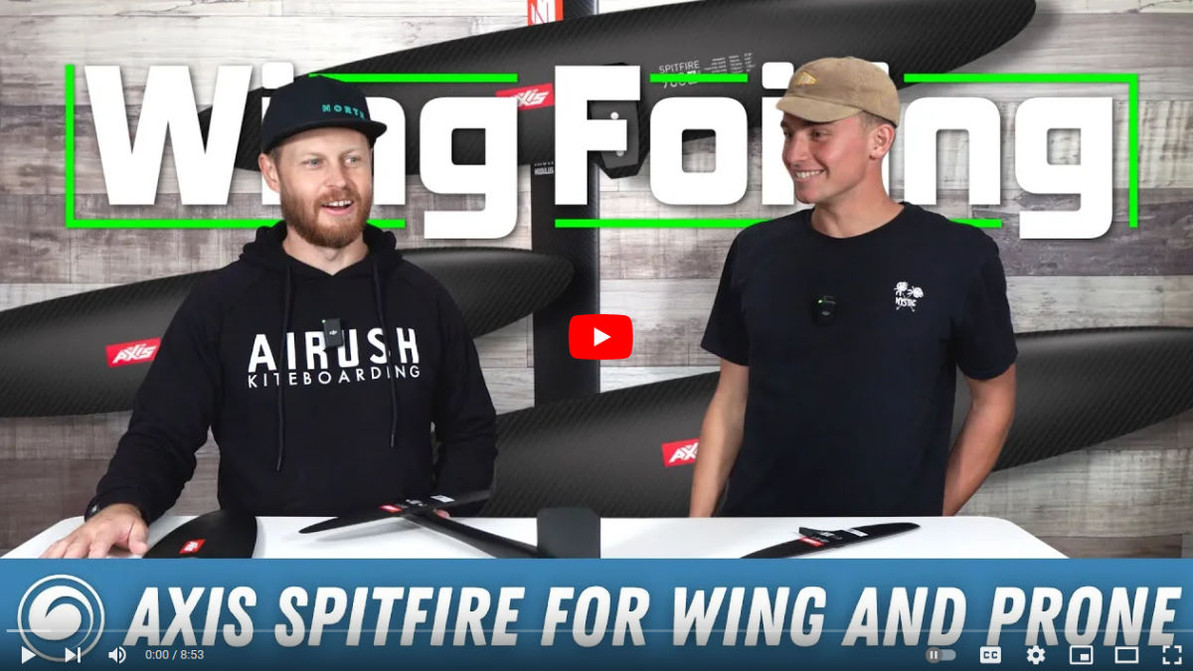Axis Spitfire Review | Excellent for Wing Foil and Prone Foil
Axis has released their new Spitfire front wings, and Ryan and Cole have had a chance to ride them. Where do these wings excel, and what sort of rider will enjoy them?
Cole: I got on the Axis Spitfire for the first time when I was prone foiling, and I was absolutely blown away by the turning performance of this wing. It pumped really well, yet it still had great edge-to-edge performance, and this is something that I haven't really seen in wings that pump well. I was able to connect three or four waves, and I wasn't absolutely gassed trying to pump it, while the down-the-line performance was still great. I also didn't feel like it was hitting the brakes. Ryan, I know you've been winging with it. How did you feel about the speed of it?

Ryan: I totally would agree with you on that edge-to-edge, side-to-side roll and carviness. It's super playful, super fun, and very impressive with how well it turns, though this is nothing surprising to me, coming from Axis. I think they did a really good job with their ART series in terms of how well that turns for a high aspect foil, too.
Like Cole said, I've just winged with it, so that's a little bit higher speed than what you typically hit when you're prone foiling, unless you're dropping in on some pitching waves, and I thought that it did pretty well. I need to play around with some different stabilizers for it since I think that makes a huge difference when you get into these mid- to high-aspect foils and the speed range that you get out of them. We had it set up with the 365 Skinny, which is one of the new series that Axis came out with that's designed to ride at higher speeds. I think it was designed more for those ART front wings, but I thought that it also paired really well with the Spitfire for winging to try to eke out a little more performance.
The pump-ability is something that I noticed was there too. I thought that it pumped really well. I need a few more sessions on it, but it seems like it needs to slow down a little bit for winging to really pump. You can't just come out of a fast downwind jibe; you've got to be going wave speed to really get this in the zone where it wants to pump. Of course, some of that has to do with the size wing that I was riding.
Cole: As Ryan was saying, when you're ripping on the wing, you're going to hit the top end speed for this foil, but on the waves it excels. It's really hard to push the limit of the speed of the Spitfire on the wave. It likes to go down the line, though you are going to hit that top end limit when you're on the wing and you're cooking upwind. Ryan, talk to me a little bit about how you felt the Spitfire performed on the low end of the speed.
Ryan: The low end was excellent. It was easy to get up and get going with a wing. You don't need a ton of power and speed to get going with the Spitfire, which is awesome, especially if you get out in some of those wave conditions where you want to pop right up and get going without having to worry about building board speed.
The other side of that is the stall speed: dropping off foil. I felt like you could stall it out to almost nothing and then pick up the wing again and take off, so that is pretty awesome. No matter what level you're riding at, as wingers it's easy to get into those situations where you're riding the wave and looking for another section to pump through, or you see something coming up and it's not quite there, or maybe you just have a little lapse in judgment, and all of a sudden you're slowing down and you realize you're about to stall out. You're still up on foil with the Spitfire, but on a lot of other wings you're slamming into the water and you're going to have to board start. How do you think it did for proning, as far as stall speed and takeoff?
Cole: I felt very similar to you. It's a very forgiving wing when you're proning with it. If you get caught really hard in your toeside or heelside edge, some of those high aspect wings don't want to turn, and all a sudden you're in the water, especially when you're trying to pump out the back and clear that wave that you're on. This wing rolled over really nicely, and you could quickly regain your stability. This helped a ton with that low end as well because, when you get off balance, sometimes you can't pump right away. This wing actually did glide a little bit and it did slow down, but it didn't drop out and make you slam into the water. You could recover and then pump out the back and catch the next wave. It's a forgiving wing both on prone and the wing.
One thing that helps the wing to be so forgiving is the symmetrical width from wingtip to wingtip across the center line. This helps a ton when you're turning and hit either current or bubbles from the breaking wave, or something on that nature. Wings that have a variable chord line width across the wing will not only pitch one side up, but will also change your pitch up and down. Because the Spitfire has that consistent width across wingtip to wingtip in the middle, your wing's only going to pitch side-to-side and not up or down, which helps it to be a very forgiving wing.

Ryan: I didn't know about that, but I did notice it while riding it. There were a couple times where I got into some turbulent water, and it was a more subtle board adjustment. There are a lot of other foils where it's a lot more noticeable.
Cole: Because you hadn't even known about it and you felt it, that design definitely isn't a gimmick. It actually works, which is really cool.
Ryan: We've been riding the Spitfire and really enjoy this wing. It's a very good foil when it comes to turning. That side-to-side, heel-to-toe performance is awesome. It's a really forgiving foil in terms of stall speed and the ability to take off on foil. It allows you to slow things down if you need to.
Cole: If you're a rider that's looking to go prone foiling, this wing is by far my favorite. I have access to all the different brands that we carry here at the shop, and the Axis Spitfire is my favorite wing to go prone on, so take that as you will. Ryan, is there anything else you want to add from the winging side? Who exactly is this wing for?
Ryan: Anyone that's looking to wing in swell or waves and wants to carve the wave top to bottom with tight turns, this is a great setup for you. It's extra forgiving in the stall speed, which makes it really fun and easy to learn to ride. It makes it easier to learn that style of riding if you're someone that's been riding straight down the wave or down the line. It's a great foil for the wingers out there that want to carve it up in the surf.
Cole: It's also a great wing for anyone looking to get out there and prone. Until next time, happy shredding, and we look forward to seeing you on the water.

MACkite Subscription Links:
YouTube | Instagram | Spotify Oddcasts
Contact MACkite Below:
800.622.4655 | Kiteboarder@MACkite.com | LIVE Chat Messenger


Recent Posts
-
Foil Drive Max vs. Slim | The Battery Breakdown For the Everyday Rider
Judging by the number of calls we get about the Gen2 Foil Drive, it's a popular choice for fo …6th Jan 2025 -
Discover Mancora and Negritos | A Kiteboarder's Paradise in Peru!
Have you ever considered traveling to northern Perú for a kite trip? Up until a couple months …3rd Jan 2025 -
Waydoo Evo eFoil Unboxing | Here's Everything You'll Get!
Although the Waydoo Evo is one of the more modestly-priced eFoil options out there, it's still …2nd Jan 2025




